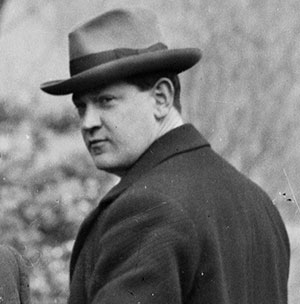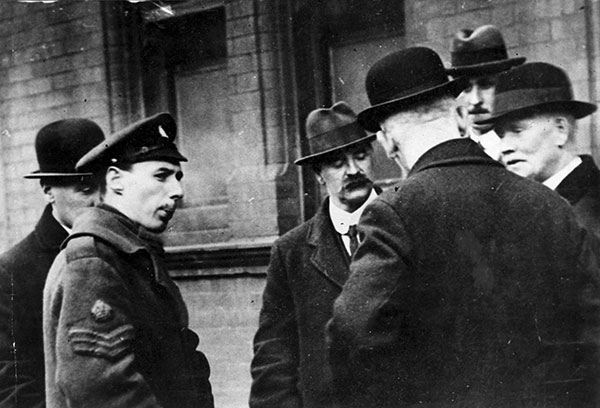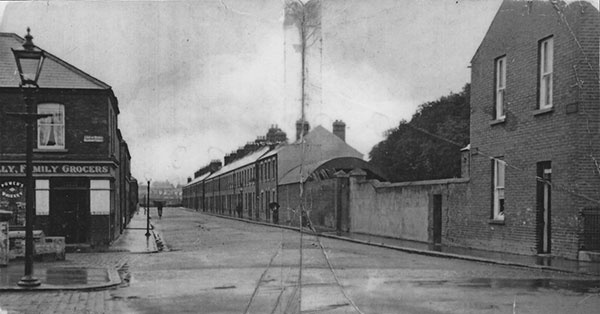Shooting ‘the Dog’
Published in Features, Issue 4 (July/August 2019), Volume 27DMP Detective Sergeant Patrick Smyth—the first G Division casualty of the War of Independence.
By Seán Ryan

Above: Michael Collins—in his role as Director of Intelligence he had long been aware of the dangers posed to the Volunteers in Dublin by the DMP’s G Division. (NLI)
The shooting of the two RIC constables in Soloheadbeg on 21 January 1919 had been followed by widespread condemnation by all sections of the community, including the Catholic Church and nationalist organisations. Although the Irish Volunteers’ newspaper, An tÓglach, stated on 1 February 1919 that the Volunteers must contemplate offensive action and that soldiers and police were liable to be treated as invading enemies, there was very little activity in this regard for the next few months. In fact, between 21 January and 30 July 1919 only four policemen were killed, and three of these were the result of attempted rescues of republican prisoners in Limerick on 6 April and at Knocklong railway station on 13 May (see HI 27.3, May/June 2019, p. 70). The only RIC officer who was deliberately targeted during that period was District Inspector Michael Hunt, who was shot dead in Thurles, Co. Tipperary, on 23 June. Éamon de Valera, in particular, was opposed to the shooting of policemen, and it was only after his departure to the United States in June 1919 that the policy of not deliberately targeting policemen was changed.
G Division
In Dublin, the unarmed and uniformed members of the Dublin Metropolitan Police (DMP) generally did not get involved in political activities. This was not the case with the G Division, originally formed in 1843, which had developed during the Fenian era into an anti-subversive force mainly engaged in watching and foiling nationalist activities.
Michael Collins, in his role as Director of Intelligence, had long been aware of the dangers posed to the Volunteers in Dublin by the G Division, and early in 1919 concerted efforts were made by Collins’s men to intimidate G Division detectives and dissuade them from pursuing republican activists. On the night of 9 April, for example, raids by armed men took place on the homes of Detective Sergeant Edward Halley and Detective Officer Denis O’Brien. O’Brien was accosted as he returned to his house in Glengarriff Parade; he was searched, tied up and left lying on the street. Halley came upon armed men in the process of ransacking his house in nearby Norfolk Road; he fired a shot from his revolver and the men ran off. Although effective in some cases (O’Brien, for example, was reported as saying, ‘I am not doing any more against them’), in others the warnings did not have the desired effect. Collins then obtained the approval of Cathal Brugha, Minister for Defence, and Richard Mulcahy, Chief-of-Staff, to arrange the execution of Detective Sergeant Smyth, who was particularly active in pursuit of republicans at this time.
Smyth’s background
Detective Sergeant Patrick Smyth was born in Lisraherty, near Granard, Co. Longford, on 28 December 1867. He was the second of eleven children born to Francis (a schoolteacher who later turned to farming) and Mary (née Murtagh). He joined the DMP in March 1893 and transferred to G Division in April 1897. He married in 1901, and he and his wife Annie resided with their seven children (aged from two to seventeen years) at 51 Millmount Avenue. Situated off the Drumcondra Road, just north of the River Tolka, Millmount Avenue was at that time a cul-de sac but otherwise is little changed today.

Above: Smyth (centre, with moustache), with other G Division detectives outside Dublin City Morgue on 13 March 1919 following the inquest on Alfred Pearson, shot dead in a raid for arms at his house in Richmond Road, Drumcondra. The man in army uniform is Pearson’s son. The tall man at the back, to Smyth’s left, is Detective Officer Daniel Hoey, who was later shot dead in Townsend Street on 12 September 1919. (Mercier Press)
Just how active Smyth was in harassing republicans can be gauged by the number of references to him in the various witness statements made to the Bureau of Military History (BMH). Michael Noyk, solicitor, who represented many imprisoned republicans, described Smyth as ‘not only an obnoxious detective officer, but he had strong anti-Sinn Féin prejudices, being a Redmondite’. Joseph V. Lawless, who commanded the Fingal Brigade, said that ‘Smyth had made himself notorious in his efforts to track down Collins and other members of the Volunteer general staff, and had been warned that his life would be forfeited if he chose to continue on this path’.
Smyth was known to republicans as ‘the Dog’, although Michael Noyk referred to him by another nickname, ‘Hoofie’. Eamon Broy, one of Collins’s men inside G Division, mentioned Smyth’s unpopularity even within the police, partly owing to his rigid approach to discipline. Another interesting comment made by Broy was that ‘Smyth was at his most dangerous when he laughed, and he laughed often’. The corollary to all this, of course, was that Smyth could be regarded as a determined and conscientious policeman, committed to upholding the law of the land. In addition, there is little doubt that he was a courageous individual, not easily intimidated.
Smyth had been responsible for the arrest of Piaras Beaslaí on 4 March 1919. Beaslaí, who also resided in Drumcondra, was accosted by Smyth and another G Division detective, Thomas Wharton, after leaving a meeting in the Mansion House. Although he was arrested in connection with a speech he had given in Rhode, Co. Offaly, Beaslaí had in his possession notes on blowing up bridges and on musketry given to him by Rory O’Connor, Director of Engineering, and Michael W. O’Reilly, Director of Training. Because of the much heavier potential jail sentence for possession of these documents, Michael Collins and Harry Boland approached Smyth and warned him of the consequences if he produced the documents. Smyth rejected the approaches and as a result Beaslaí was sentenced to two years’ imprisonment.

Above: Millmount Avenue was at that time a cul-de sac but otherwise is little changed today. (Sergeant Anthony Rae [rtd], UK Police Roll of Honour)
Jim Slattery, a member of the 2nd Battalion, who resided at 9 Woodville Road, off Botanic Avenue, described in his BMH statement how a special team of four Volunteers was selected to carry out the shooting of Detective Sergeant Smyth. About mid-July 1919, Slattery was summoned to attend a meeting in 35 North George’s Street. Dick McKee, Commandant of the Dublin Brigade, and Mick McDonnell, 2nd Battalion Quartermaster, conducted the meeting. McKee specifically asked the Volunteers present whether they had any objection to shooting enemy agents. Many present demurred for one reason or another, but among those who accepted the proposition were Slattery himself, Tom Keogh, Tom Ennis and Mick Kennedy, all of whom were later to become members of Collins’s ‘Squad’ when it was subsequently formed.
According to Slattery, this four-man team waited at Drumcondra Bridge for several nights watching for Smyth, who usually came home by tram, alighted at Botanic Avenue and walked across the bridge to Millmount Avenue. Although Kennedy knew Smyth by sight, he failed to recognise him on one of the nights, particularly when, after crossing the bridge, he went past Millmount Avenue and turned into Millbourne Avenue instead. The unit returned on the night of 30 July, however, and the four men opened fire on Smyth with .38 revolvers just as he turned the corner into Millmount Avenue.
Although hit several times, Smyth managed to run up the Avenue, pursued by the Volunteers, who continued to fire at him. When he got to within fifteen yards of his doorway at No. 51, his son Thomas and daughter Mary came to his assistance and the assailants ran off. Smyth’s other son, Francis, then helped his father back to his house, while the fourteen-year-old Thomas followed the gunmen as they ran from the scene. According to him, two of them turned up the laneway to Millbourne Avenue, while the others escaped across the waste ground adjacent to the River Tolka.
DMP Constable Terence O’Reilly, on patrol on Drumcondra Road, heard the shots and arrived to find the badly wounded Smyth back in his house. Constable O’Reilly returned to the bridge and telephoned for an ambulance from the fire alarm station there.
Joseph V. Lawless of the Fingal Brigade was that night standing at the door of Flemings’ shop at 140 Lower Drumcondra Road, beside Fagan’s public house, when he heard the volley of shots from just beyond the bridge over the Tolka. About twenty minutes later, the Dublin Fire Brigade ambulance went clattering over the bridge. Lawless walked over to Millmount Avenue—quite a crowd had gathered there—and was just in time to see Smyth being carried from his house to the ambulance. Joe Connolly, the ambulance driver, known to Lawless as a Volunteer, remarked to him, rather disappointedly, ‘I don’t think he is dead yet’. The ambulance then left for the Mater Hospital with the wounded detective.
Subsequent death and inquest
The following day the badly wounded Smyth made a statement to DMP Station Sergeant J. Lynch in the Mater Hospital. He described the shooting but could not identify any of his assailants. On the day after the shooting, his daughter Mary was quoted as saying:
‘Was it not a cowardly thing to shoot him in the back without giving him a chance of defending himself, but he always carried a revolver but he hadn’t it with him last night so that he could not put up a fight against his would-be murderers’.
Detective Sergeant Patrick Smyth died in the Mater Hospital on Monday 8 September 1919. An inquest was held on Wednesday 10 September and was presided over by Dr Louis Byrne, Dublin City Coroner. The inquest heard evidence from the Mater Hospital doctors, Smyth’s two sons, Thomas and Francis, Constable O’Reilly and Station Sergeant Lynch. Smyth’s wife also attended but was not called to give evidence. At the time of the shooting she had been away in the country with three of her children.
Dr P.J. Butterly, house surgeon at the Mater, gave evidence that Smyth had suffered five bullet wounds—in the ribs, the left loin, the right thigh, the left buttock and the right hip. Death in his opinion was caused by abscess of the lung, a result of the bullet that traversed the lung.
When Constable O’Reilly gave his evidence concerning his arrival on the scene, he said that he saw none of the gunmen. This provoked an interesting interjection from one of the jurors, who thought it strange that the constable was unable to identify any of the men. The coroner, however, said that this was not a question but a statement, which should not be made in open court.
The jury returned a verdict in accordance with the medical evidence and added that ‘we are of the opinion that the above conditions were caused by bullets fired by a person, or persons, unknown, with murderous intent’.
Buried in Glasnevin Cemetery

Above: Smyth’s grave in Glasnevin Cemetery today.
After Requiem Mass in Mount Argus on Thursday 11 September, Detective Sergeant Smyth was buried in Glasnevin Cemetery. His funeral was semi-private, being attended by immediate relatives and friends, government officials and his colleagues of the G Division and the DMP.
Subsequently, on 13 November 1919 in Green Street courthouse, his widow Annie was awarded £1,750 plus costs in compensation for the death of her husband. This award was to be levied off the City and County of Dublin equally. She had claimed £10,000. The court was told that Detective Sergeant Smyth’s pay was 58 shillings per week, together with a war bonus and other allowances.
According to posts on the irishconstabulary.com website, Mrs Smyth and some of the family moved to Blackpool in England, where she opened a boarding house in the early 1920s. It was alleged that the family suffered intimidation and threats following the death of her husband and were forced to leave the country.
The Volunteers concluded from the shooting that .38 revolvers were not adequate and steps were taken to replace them with the heavier .45 calibre revolvers for future operations of this nature. And there were further shootings to follow. The public reaction to the death of Detective Sergeant Smyth was muted compared with the general outrage expressed after earlier shootings of policemen. On 12 September, the day after Smyth was buried, Detective Officer Daniel Hoey, G Division, was shot dead in Townsend Street, and on 29 November Detective Sergeant John Barton, G Division, was shot dead in College Street.
In Drumcondra, on Friday 12 December 1919, there was an attempted assassination of another G Division officer, Detective Officer Walsh. He was returning to his home in Fitzroy Avenue at about 8pm when two gunmen opened fire on him from the corner of May Street. He was not hit and returned fire at the fleeing gunmen. It was reported that Walsh had been engaged in office duties for G Division since he joined the force in 1908.
The death of Detective Sergeant Smyth on 8 September 1919, together with the shooting of a British soldier in Fermoy on Sunday 7 September, influenced the decision on Wednesday 10 September to extend the ban on Sinn Féin and other nationalist organisations.
Seán Ryan is a local historian from Drumcondra.
FURTHER READING
B. Abbott, Police casualties in Ireland 1919–1922 (Cork, 2000).
Bureau of Military History, WS 707 (Michael Noyk), WS 1043 (J.V. Lawless) & WS 445 (James J. Slattery).
J. Herlihy, The Dublin Metropolitan Police (Dublin, 2001).
















